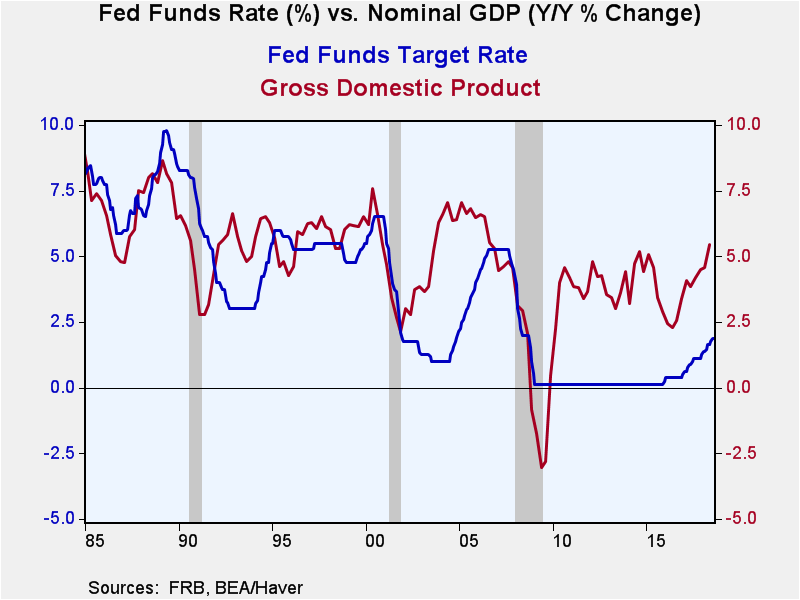 Global| Sep 11 2018
Global| Sep 11 2018Fed Policy: In Search of Rate Neutrality
|in:Viewpoints
Summary
Federal Reserve policymakers have clearly indicated their intentions to raise official rates by 25 basis points at the September 25-26 Federal Open Market Committee Meeting. Yet, one of the more contentious issues that may be [...]
 Federal Reserve policymakers have clearly indicated their intentions to raise official rates by 25 basis points at the September 25-26 Federal Open Market Committee Meeting. Yet, one of the more contentious issues that may be discussed at the meeting is “rate neutrality”, or the level of official rates that is neither accommodative nor restrictive.
Federal Reserve policymakers have clearly indicated their intentions to raise official rates by 25 basis points at the September 25-26 Federal Open Market Committee Meeting. Yet, one of the more contentious issues that may be discussed at the meeting is “rate neutrality”, or the level of official rates that is neither accommodative nor restrictive.
Rate neutrality is not well defined for the simple reason it is a moveable target and largely determined by several factors, including the stance of fiscal policy, the growth in nominal GDP, and the current and prospective rate of inflation. Today, all three factors suggest that a neutral level of official rates is in the 4.5% to 5.5% range, far above what policymakers have indicated in their quarterly projections. Here’s why.
Fiscal policy is providing a lot of stimulus to the economy in the form of tax reduction, investment incentives and increased spending. The increase in federal spending is often overlooked but it might be providing more of a lift to the current growth spurt than tax reduction. Keep in mind that in February Congress passed legislation that raised spending on defense and non-defense discretionary programs by $300 billion over a two-year period. That legislation has lifted nominal government spending to a current run rate of 5% annually, after showing no growth in the past several years.
Nominal GDP growth is often a reliable benchmark for official interest rates since monetary policy has its greatest influence on nominal (or money) GDP and the marketplace determines the split between real and inflation. Nominal GDP is running 5.4% in the last 12 months, and could top 6% by the end of the year for the first time since 2005.
Consumer price inflation is running close to 3% and core inflation (or total consumer prices less food and energy) has increased 2.4%. Both readings represent the highest rates of inflation in several years. And the risk of consumer price moving higher in coming quarters is growing with each passing day given the tight labor markets, rising wage growth and increased costs of materials and supplies related to tariffs on foreign goods.
Policymakers for many years have operated with the idea that the neutral rate of official rates was very low, and that view had a lot of support with very low readings on inflation, restrictive fiscal policy, high unemployment and weak wage growth, and anemic growth in nominal GDP.
Yet, today the economic and fiscal climate is fundamentally different requiring a new look at what is a neutral level of official rates. The next 25 basis points increase in the federal funds rate will only lift the policy rate to around 2.25%, which is half the estimated new neutral rate given the growth in nominal GDP and the upside risks on inflation.
Viewpoint commentaries are the opinions of the author and do not reflect the views of Haver Analytics.Joseph G. Carson
AuthorMore in Author Profile »Joseph G. Carson, Former Director of Global Economic Research, Alliance Bernstein. Joseph G. Carson joined Alliance Bernstein in 2001. He oversaw the Economic Analysis team for Alliance Bernstein Fixed Income and has primary responsibility for the economic and interest-rate analysis of the US. Previously, Carson was chief economist of the Americas for UBS Warburg, where he was primarily responsible for forecasting the US economy and interest rates. From 1996 to 1999, he was chief US economist at Deutsche Bank. While there, Carson was named to the Institutional Investor All-Star Team for Fixed Income and ranked as one of Best Analysts and Economists by The Global Investor Fixed Income Survey. He began his professional career in 1977 as a staff economist for the chief economist’s office in the US Department of Commerce, where he was designated the department’s representative at the Council on Wage and Price Stability during President Carter’s voluntary wage and price guidelines program. In 1979, Carson joined General Motors as an analyst. He held a variety of roles at GM, including chief forecaster for North America and chief analyst in charge of production recommendations for the Truck Group. From 1981 to 1986, Carson served as vice president and senior economist for the Capital Markets Economics Group at Merrill Lynch. In 1986, he joined Chemical Bank; he later became its chief economist. From 1992 to 1996, Carson served as chief economist at Dean Witter, where he sat on the investment-policy and stock-selection committees. He received his BA and MA from Youngstown State University and did his PhD coursework at George Washington University. Honorary Doctorate Degree, Business Administration Youngstown State University 2016. Location: New York.


